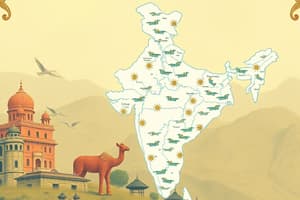Podcast
Questions and Answers
When did India initiate its liberalizing process with the New Economic Policy?
When did India initiate its liberalizing process with the New Economic Policy?
- Early 2000s
- Late 1980s (correct)
- Late 1990s
- Early 1980s
Under whose leadership did China implement market-oriented economic reforms known as the Four Modernizations?
Under whose leadership did China implement market-oriented economic reforms known as the Four Modernizations?
- Hu Jintao
- Mao Zedong
- Deng Xiaoping (correct)
- Xi Jinping
When did Pakistan's economic transformation begin primarily through structural adjustment programs?
When did Pakistan's economic transformation begin primarily through structural adjustment programs?
- Early 1980s
- Early 2000s
- Late 1990s (correct)
- Late 1970s
Which countries have become world leaders in terms of GDP size and annual percentage increase rates since the beginning of the 1990s?
Which countries have become world leaders in terms of GDP size and annual percentage increase rates since the beginning of the 1990s?
Which country's economic liberalization resulted in substantial increases in GDP?
Which country's economic liberalization resulted in substantial increases in GDP?
Which nation's journey towards progress emphasizes deregulation, privatization, and global integration?
Which nation's journey towards progress emphasizes deregulation, privatization, and global integration?
Which country in the trio mentioned has the highest literacy rate according to UNESCO estimates?
Which country in the trio mentioned has the highest literacy rate according to UNESCO estimates?
What factor contributes to Chinese and Indian actors wielding more influence in regional affairs?
What factor contributes to Chinese and Indian actors wielding more influence in regional affairs?
Which country has lagged behind in economic growth despite experiencing moderate growth?
Which country has lagged behind in economic growth despite experiencing moderate growth?
What has driven India and Pakistan to enhance industrial capabilities?
What has driven India and Pakistan to enhance industrial capabilities?
Which initiative offers strategic advantages and challenges related to trade among China, India, and Pakistan?
Which initiative offers strategic advantages and challenges related to trade among China, India, and Pakistan?
In which industry does China dominate and lead in cutting edge innovation according to the text?
In which industry does China dominate and lead in cutting edge innovation according to the text?
Flashcards are hidden until you start studying
Study Notes
Comparing Economic Progress and Development Among India, China, and Pakistan
A comprehensive examination of India, China, and Pakistan's journey towards progress reveals intriguing similarities and notable distinctions across several key areas of their socioeconomic landscapes. In this exploration, we delve into the comparative development of these countries primarily through lenses of economic reforms, economic growth, social development, trade policies, and industrialization.
Economic Reforms
India initiated its liberalizing process during the late 1980s with the New Economic Policy, emphasizing deregulation, privatization, and global integration. China followed suit in the early '80s under Deng Xiaoping's leadership, propelling market-oriented economic reforms known as the Four Modernizations. Pakistan's economic transformation began later, largely driven by structural adjustment programs introduced throughout the 1990s. These efforts have yielded varying degrees of success among the three nations.
Economic Growth
Since embarking upon economic liberalization, all three countries have experienced substantial increases in GDP. However, there is considerable divergence regarding their paces and levels of expansion over time. Since the beginning of the 1990s, both China and India have grown exponentially, becoming world leaders in terms of GDP size and annual percentage increase rates. Conversely, Pakistan has lagged behind despite experiencing moderate growth—its per capita income remains lower than those of India and China. This disparity can partly explain why Chinese and Indian actors often wield more influence when it comes to regional affairs.
Social Development
Social welfare indices reveal significant variations amidst the trio. For instance, life expectancy rates differ greatly, with India averaging approximately 67 years while Pakistan and China typically see higher figures nearing seven decades—a clear indicator highlighting health care quality and overall living standards. Illiteracy also contrasts considerably; according to UNESCO estimates from 2019, literacy rates are highest in China, followed by India and Pakistan respectively. Moreover, gender inequality persists within these societies, particularly where access to education and employment opportunities remain unevenly distributed between men and women.
Trade Policies
Trade has become increasingly vital amongst these neighbors, fostering interdependence yet complicating relations between them due to geopolitical, territorial, and ideological differences. Tariff reductions, free trade agreements, infrastructure connectivity projects like CPEC, BRI, and ASEAN-led initiatives offer strategic advantages and challenges alike. Most notably, China has emerged as a manufacturing powerhouse, driving export dependency in neighboring economies such as India and Pakistan—a reality that carries widespread ramifications concerning job creation, poverty reduction, and national security concerns.
Industrialization
The pursuit for self-reliance coupled with the desire to diversify exports has driven each country to enhance industrial capabilities. Despite some setbacks caused by protectionist measures and slow adoption of new technologies, India and Pakistan have recently shown promising signs of modernizing traditional sectors such as textiles, automobiles, pharmaceuticals, and information technology. Meanwhile, China continues to dominate in virtually every industry and leads in cutting edge innovation in robotics, artificial intelligence, quantum computing, electric vehicles, etc.. As such, competition for foreign direct investment intensifies whilst technological cooperation and knowledge transfer between these nations becomes evermore critical.
In conclusion, a nuanced understanding of the evolutionary trajectories of India, China, and Pakistan demands contextual appreciation of their unique histories, institutions, and cultural dynamics. Each nation's achievements and struggles form part of a larger tapestry representing the dynamic interplay between political willpower, creative policy design, public engagement, and societal resilience in the face of change.
Studying That Suits You
Use AI to generate personalized quizzes and flashcards to suit your learning preferences.




